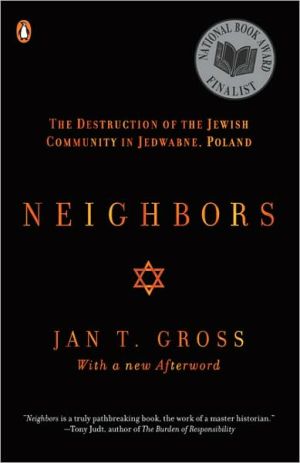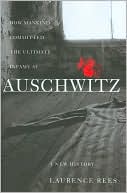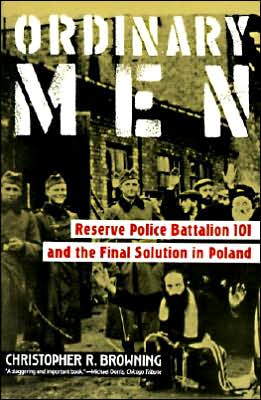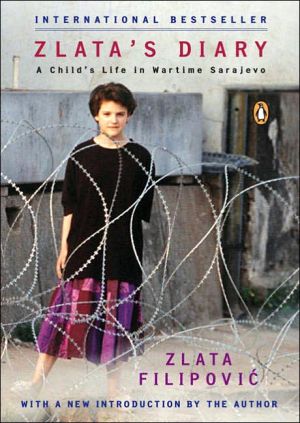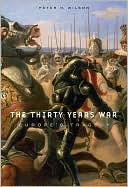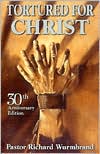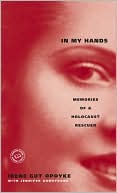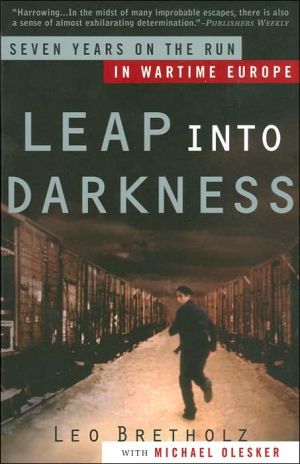Neighbors: The Destruction of the Jewish Community in Jedwabne, Poland
One summer day in 1941, half of the Polish town of Jedwabne murdered the other half—1600 men, women, and children—all but seven of the town's Jews. Neighbors tells their story.\ This is a shocking, brutal story that has never before been told. It is the most important study of Polish-Jewish relations to be published in decades and should become a classic of Holocaust literature.\ Jann Gross pieces together eyewitness accounts and other evidence into an engulfing reconstruction of the horrific...
Search in google:
"Neighbors is a truly pathbreaking book, the work of a master historian. Jan Gross has a shattering tale to tell, and he tells it with consummate skill and control. The impact of his account of the massacre of the Jews of Jedwabne by their Polish neighbors is all the greater for the calm, understated narration and Gross's careful reconstruction of the terrifying circumstances in which the killing was undertaken. But this little book is much, much more than just another horror story from the Holocaust. In his imaginative reflections upon the tragedy of Jedwabne, Gross has subtly recast the history of wartime Poland and proposed an original interpretation of the origins of the postwar Communist regime. This book has already had dramatic repercussions in Poland, where it has single-handedly prised open a closed and painful chapter in that nation's recent past. But Neighbors is not only about Poland. It is a moving and provocative rumination upon the most important ethical issue of our age. No one who has studied or lived through the twentieth century can afford to ignore it."--Tony Judt, Director, Remarque Institute"This tiny book reveals a shocking story buried for sixty years, and it has set of a round of soul searching in Poland. But the questions it raises are of universal significance: How do 'ordinary men' turn suddenly into 'willing executioners?' What, if anything, can be learned from history about 'national character?' Where do we draw the line between legitimately assigning present responsibility for wrongs perpetrated by previous generations and unfairly visiting the sins of the fathers on the children? The author has no facile answers to these problems, but his story asks us to think about them in new ways."--David Engel, author of The Holocaust: The Third Reich and the Jews"This is unquestionably one of the most important books I have read in the last decade both on the general question of the mass murder of the Jews during World War II and on the more specific problem of the reaction of Polish society to that genocide. All of the issues it raises are handled with consummate mastery. I finished this short book both appalled at the events it describes and filled with admiration for the wise and all-encompassing skill with which the painful, difficult, and complex subject has been handled."--Antony Polonsky, Brandeis University New York Times - Adam Michnik To these people, Jan Tomasz Gross's book Neighbors, which revealed the story of the murder by Poles of 1,600 Jews in Jedwabne, was a terrible shock. It is difficult to describe the extent of this shock. Mr. Gross's book has generated a heated response comparable to the Jewish community's reaction to the publication of Hannah Arendt's Eichmann in Jerusalem.
On January 8, 1949, in the small town of Jedwabne, some nineteen kilometers from Lomz in Poland's historical province of Mazowsze, security police detained fifteen men. We find their names in a memorandum ominously called Raport likwidacyjny (A liquidation report) among the so-called control-investigative files (akta kontrolno-sledcze) kept by the security police to monitor their own progress in each investigation.1 Among the arrested, mostly small farmers and seasonal workers, there were two shoemakers, a mason, a carpenter, two locksmiths, a letter carrier, and a former town-hall receptionist. Some were family men (one a father of six children, another of four), some still unattached. The youngest was twenty-seven years old, the oldest sixty-four. They were, to put it simply, a bunch of ordinary men.2\ Jedwabne's inhabitants, at the time totaling about two thousand, must have been shocked by the simultaneous arrests of so many local residents.3 The wider public got a glimpse of the whole affair four months later, when, on May 16 and 17 in the District Court of Lomz, Boleslaw Ramotowski and twenty-one codefendants were put on trial. The opening sentence of the indictment reads, "Jewish Historical Institute in Poland sent materials to the Ministry of Justice describing criminal activities of the inhabitants of Jedwabne who engaged in the murder of Jewish people, as stated in the testimony of Szmul Wasersztajn who witnessed the pogrom of the Jews."4\ There are no records at the Jewish Historical Institute (JHI) telling us how or when Wasersztajn's deposition was communicated to the prosecutor's office. On the basis of the court files, likewise, it is impossible to know, for example, when the prosecution was informed about what had happened in Jedwabne, and why the indictment was so long delayed. The control-investigative files from the Lomz Security Office shed some light on the matter, but they are also inconclusive.5 In any case, Wasersztajn gave his testimony before the Jewish Historical Commission in Bialystok on April 5, 1945. And this is what he said:\ Before the war broke out, 1,600 Jews lived in Jedwabne, and only seven survived, saved by a Polish woman, Wyrzykowska, who lived in the vicinity.\ On Monday evening, June 23, 1941, Germans entered the town. And as early as the 25th local bandits, from the Polish population, started an anti-Jewish pogrom. Two of those bandits, Borowski (Borowiuk?) Wacek with his brother Mietek, walked from one Jewish dwelling to another together with other bandits playing accordion and flute to drown the screams of Jewish women and children. I saw with my own eyes how those murderers killed Chajcia Wasersztajn, Jakub Kac, seventy-three years old, and Eliasz Krawiecki.\ Jakub Kac they stoned to death with bricks. Krawiecki they knifed and then plucked his eyes and cut off his tongue. He suffered terribly for twelve hours before he gave up his soul.\ On the same day I observed a horrible scene. Chaja Kubrzanska, twenty-eight years old, and Basia Binsztajn, twenty-six years old, both holding newborn babies, when they saw what was going on, they ran to a pond, in order to drown themselves with the children rather than fall into the hands of bandits. They put their children in the water and drowned them with their own hands: then Baska Binsztajn jumped in and immediately went to the bottom, while Chaja Kubrzanska suffered for a couple of hours. Assembled hooligans made a spectacle of this. They advised her to lie face down in the water, so that she would drown faster. Finally, seeing that the children were already dead, she threw herself more energetically into the water and found her death too.\ The next day a local priest intervened, explaining that they should stop the pogrom, and that German authorities would take care of things by themselves. This worked, and the pogrom was stopped. From this day on the local population no longer sold foodstuffs to Jews, which made their circumstances all the more difficult. In the meantime rumors spread that the Germans would issue an order that all the Jews be destroyed.\ Such an order was issued by the Germans on July 10, 1941.\ Even though the Germans gave the order, it was Polish hooligans who took it up and carried it out, using the most horrible methods. After various tortures and humiliations, they burned all the Jews in a barn. During the first pogrom and the later bloodbath the following outcasts distinguished themselves by their brutality: Szlezinski, Karolak, Borowiuk (Borowski?) Mietek, Borowiuk (Borowski?) Waclaw, Jermalowski, Ramutowski Bolek, Rogalski Bolek, Szelawa Stanislaw, Szelawa Franciszek, Kozlowski Geniek, Trzaska, Tarnoczek Jerzyk, Ludanski Jurek, Laciecz Czeslaw.\ On the morning of July 10, 1941, eight gestapo men came to town and had a meeting with representatives of the town authorities. When the gestapo asked what their plans were with respect to the Jews, they said, unanimously, that all Jews must be killed. When the Germans proposed to leave one Jewish family from each profession, local carpenter Bronislaw Szlezinski, who was present, answered: We have enough of our own craftsmen, we have to destroy all the Jews, none should stay alive. Mayor Karolak and everybody else agreed with his words. For this purpose Szlezinski gave his own barn, which stood nearby. After this meeting the bloodbath began.\ Local hooligans armed themselves with axes, special clubs studded with nails, and other instruments of torture and destruction and chased all the Jews into the street. As the first victims of their devilish instincts they selected seventy-five of the youngest and healthiest Jews, whom they ordered to pick up a huge monument of Lenin that the Russians had erected in the center of town. It was impossibly heavy, but under a rain of horrible blows the Jews had to do it. While carrying the monument, they also had to sing until they brought it to the designated place. There, they were ordered to dig a hole and throw the monument in. Then these Jews were butchered to death and thrown into the same hole.\ The other brutality was when the murderers ordered every Jew to dig a hole and bury all previously murdered Jews, and then those were killed and in turn buried by others. It is impossible to represent all the brutalities of the hooligans, and it is difficult to find in our history of suffering something similar.\ Beards of old Jews were burned, newborn babies were killed at their mothers' breasts, people were beaten murderously and forced to sing and dance. In the end they proceeded to the main action—the burning. The entire town was surrounded by guards so that nobody could escape; then Jews were ordered to line up in a column, four in a row, and the ninety-year-old rabbi and the shochet [Kosher butcher] were put in front, they were given a red banner, and all were ordered to sing and were chased into the barn. Hooligans bestially beat them up on the way. Near the gate a few hooligans were standing, playing various instruments in order to drown the screams of horrified victims. Some tried to defend themselves, but they were defenseless. Bloodied and wounded, they were pushed into the barn. Then the barn was doused with kerosene and lit, and the bandits went around to search Jewish homes, to look for the remaining sick and children. The sick people they found they carried to the barn themselves, and as for the little children, they roped a few together by their legs and carried them on their backs, then put them on pitchforks and threw them onto smoldering coals.\ After the fire they used axes to knock golden teeth from still not entirely decomposed bodies and in other ways violated the corpses of holy martyrs.6\ While it is clear to a reader of Wasersztajn's deposition that Jews were annihilated in Jedwabne with particular cruelty, it is difficult at first to fully absorb the meaning of his testimony. And, in a way, I am not at all surprised that four years had elapsed between the time when he made his statement and the beginning of the Lomz trial. This is, more or less, the amount of time that elapsed between my discovery of Wasersztajn's testimony in JHI's archives and my grasp of its factuality. When in the autumn of 1998 I was asked to contribute an article to a Festschrift prepared for Professor Tomasz Strzembosz—a well-known historian who specialized in wartime history of the Bialystok region—I decided to use the example of Jedwabne to describe how Polish neighbors mistreated their Jewish cocitizens. But I did not fully register then that after the series of killings and cruelties described by Wasersztajn, at the end of the day all the remaining Jews were actually burned alive in a barn (I must have read this as a hyperbolic trope, concluding that only some had been killed that way). A few months after I submitted my essay, I watched raw footage for the documentary film Where Is My Older Brother Cain? made by Agnieszka Arnold, who, among other interlocutors, spoke with the daughter of Bronislaw Sleszynski, and I realized that Wasersztajn has to be taken literally.\ As the book had not yet been published, I wondered whether I should withdraw my chapter. However, I decided to leave the chapter unchanged, because one important aspect of the Jedwabne story concerns the slow dawning of Polish awareness of this horrendous crime. How did this event figure (or, rather, fail to figure) in the consciousness of historians of the war period—myself included? How did the population of Jedwabne live for three generations with the knowledge of these murders? How will the Polish citizenry process the revelation when it becomes public knowledge?\ In any case, once we realize that what seems inconceivable is precisely what happened, a historian soon discovers that the whole story is very well documented, that witnesses are still alive, and that the memory of this crime has been preserved in Jedwabne through the generations.\ —Reprinted from Neighbors by Jan T. Gross by permission of Penguin Books, a member of Penguin Putnam Inc. Copyright © 2002, Jan T. Gross. All rights reserved. This excerpt, or any parts thereof, may not be reproduced in any form without permission
Acknowledgments ix Introduction 3 Outline of the Story 14 Sources 23 Before the War 33 Soviet Occupation, 1939-1941 41 The Outbreak of the Russo-German War and the Pogrom in Radzilow 54 Preparations 72 Who Murdered the Jews of Jedwabne? 79 The Murder 90 Plunder 105 Intimate Biographies 111 Anachronism 122 What Do People Remember? 126 Collective Responsibility 132 New Approach to Sources 138 Is It Possible to Be Simultaneously a Victim and a Victimizer?143 Collaboration 152 Social Support for Stalinism 164 For a New Historiography 168 Postscript 171 Notes 205 Index 249
\ From Barnes & NobleA National Book Award nonfiction nominee, Neighbors tells the chilling story of the Polish town of Jedwabne, where, on a summer's day in 1941, half of the town's population murdered the other half. Sixteen hundred Jewish men, women, and children were killed, leaving only seven of the town's Jews alive. Jan Gross has pieced together eyewitness accounts and other evidence to paint a terrifying picture of Polish-Jewish relations, and how they went horrifyingly wrong one tragic day.\ \ \ \ \ Adam MichnikTo these people, Jan Tomasz Gross's book Neighbors, which revealed the story of the murder by Poles of 1,600 Jews in Jedwabne, was a terrible shock. It is difficult to describe the extent of this shock. Mr. Gross's book has generated a heated response comparable to the Jewish community's reaction to the publication of Hannah Arendt's Eichmann in Jerusalem.\ — New York Times\ \ \ Josh MargolinGross' work so pierced the very fabric of Polish culture that the democratic government of the new Poland opened an investigation into the massacre that even included the exhumation of 200 of the victims' bodies. Ultimately, the Polish government acknowledged publicly that Poles - "ordinary men," as Gross writes - committed the Jedwabne "pogrom" and, on the 60th anniversary, President Aleksander Kwasniewski led a controversial ceremony of mourning at the site of the barn.\ — Newark Star-Ledger\ \ \ \ \ Publishers WeeklyClaude Lanzman's myth-shattering documentary film Shoah demonstrated that some Polish peasants were keenly aware of the Nazis' mass murder of Jews on Polish soil. This volume takes the real-life horror story a step further, documenting how nearly all of the Jews of Jedwabne, Poland, were murdered on one day most of them burned alive by their non-Jewish neighbors. Drawing on testimony that prompted and emanated from a 1949 Polish trial, Gross carefully describes how apparently normal citizens terrorized and killed approximately 1,600 Jewish villagers. Gross, a professor of politics and European studies at New York University, also attempts to place this heinous crime in historical and political context, concluding that he can explain but not fully understand. How to understand the Polish villagers, led by their mayor, exceeding the July 10, 1941, command of conquering German soldiers to annihilate the Jews but spare some tradesmen? Immediately,according to Gross, local townsmen-turned-hooligans grabbed clubs studded with nails and other weapons and chased the Jews into the street. Many tried to escape through the surrounding fields, but only seven succeeded. The thugs fatally shot many Jews after forcing them to dig mass graves. They shoved the remaining hundreds of Jews into a barn, doused it with kerosene and set it ablaze. Some on the outside played musical instruments to drown out the victims' cries. Yet Neighbors isn't as terrifying as one might expect, since Gross, a Polish migr himself, guides the reader along an analytical path. By de-emphasizing the drama, he helps readers cope with the awful incident, but his narrative occasionally bogs down in his own thoughts. Still, he asserts hopefully that young Poles are "ready to confront the unvarnished history of Polish-Jewish relations during the war." (May) Forecast: The always heated question of the role of Poles in the Holocaust comes to a head here. The book is bound to generate controversy (it has already garnered mention in the New York Times), though its sales will probably be limited. Copyright 2001 Cahners Business Information.\ \ \ \ \ NewsweekSixty years ago, on July 10, 1941, half the Polish town of Jedwabne murdered the other half. Why did the murderers do it? Prof. Jan Gross of New York University may not fully realize he has found the answer. It is in his astonishing little book. The title, Neighbors, is an ice dagger to the heart, but only after the book has been read.\ — George F. Will\ \ \ \ \ Financial TimesNeighbors strikes squarely at Poland's accepted historical narrative . . . One Polish critic compares the gathering controversy to the uproar with which Germans greeted Hitler's Willing Executioners, Daniel Goldhagen's 1996 study of civilian participation in the Holocaust.\ — John Reed\ \ \ \ \ Times Literary Supplement\ Horrifying and thoughtful.\ \ \ \ \ New York Times Book ReviewAn important contribution to the literature of human bestiality unleashed by war. Neighbors tells a story that has long been known in Poland but one that has shocked the rest of the world and even, it seems, the Poles themselves . . . [A] fine, careful book about the awful massacre in Jebwabne . . . [Gross] is cautious and fair to the facts.\ — Steven Erlanger\ \ \ \ \ London Review of Books[Gross] brings much art to the enterprise.Neighbors is possessed of the key virtues: moral energy, commitment to accuracy, and the maintenance of a continuing open dialogue between historian, sources, and reader.\ — Inga Clendinnen\ \ \ \ \ The ObserverNothing can make up for the horror. But if the screams of those burning alive at Jedwabne are heard at last, they may not have been completely in vain.\ — George Steiner\ \ \ \ \ The New Leader[This] small book detailing the massacre of the Jews of Jedwabne raises large questions about the roles Poles and Germans played in some of the boodiest actions against Jews during World War II. . . . Neighbors tells a compelling story admirably. It should be widely read and discussed, for the complex, unsettling issues it raises still need to be fully explored. . . .\ — Alvin H. Rosenfeld\ \ \ \ \ NewsweekNothing could have prepared the 1,600 Jews in Jedwabne, a town in northeast Poland, for the hell of their final days in the summer of 1941. . . . It is an especially gruesome Holocaust horror story. But it is a tale that, 60 years later, has stunned Poland. For what Poles have learned recently is that the perpetrators in this case weren't Germans, though the Nazi occupiers clearly approved the slaughter. They were Poles, the Jedwabne neighbors of the Jews. And the revelation of their role has triggered a wave of agonized soul-searching since it emerged . . . in Neighbors, a slim, carefully researched book [that] has guaranteed that Poles will never see their wartime history in the same way. . . . The controversy over Neighbors is already spreading across the Atlantic.\ \ \ \ \ Financial TimesNeighbors strikes squarely at Poland's accepted historical narrative . . . One Polish critic compares the gathering controversy to the uproar with which Germans greeted Hitler's Willing Executioners, Daniel Goldhagen's 1996 study of civilian participation in the Holocaust.\ \ \ \ \ Times Literary SupplementThe first question that leaps to mind is why the story of a massacre so monstrous, and of such historic significance, should surface only now, half a century after the fact. The answer to this question is both startling and complex. . . . A detailed account is provided by the sociologist and historian Jan T. Gross in his book. . . Gross's scrupulously documented study challenges another cherished myth: the noble attempts of most Poles to save Jews.\ \ \ \ \ New York Times Book ReviewAn important contribution to the literature of human bestiality unleashed by war. Neighbors tells a story that has long been known in Poland but one that has shocked the rest of the world and even, it seems, the Poles themselves . . . [A] fine, careful book about the awful massacre in Jebwabne . . . [Gross] is cautious and fair to the facts.\ \ \ \ \ The ObserverNothing can make up for the horror. But if the screams of those burning alive at Jedwabne are heard at last, they may not have been completely in vain.\ \ \ \ \ The New Leader[This] small book detailing the massacre of the Jews of Jedwabne raises large questions about the roles Poles and Germans played in some of the boodiest actions against Jews during World War II. . . . Neighbors tells a compelling story admirably. It should be widely read and discussed, for the complex, unsettling issues it raises still need to be fully explored. . . .\ \ \ \ \ NewsweekSixty years ago, on July 10, 1941, half the Polish town of Jedwabne murdered the other half. Why did the murderers do it? Prof. Jan Gross of New York University may not fully realize he has found the answer. It is in his astonishing little book. The title, Neighbors, is an ice dagger to the heart, but only after the book has been read.\ \ \ \ \ London Review of Books[Gross] brings much art to the enterprise.Neighbors is possessed of the key virtues: moral energy, commitment to accuracy, and the maintenance of a continuing open dialogue between historian, sources, and reader.\ \ \ \ \ Time Magazines Literary SupplementHorrifying and thoughtful.\ \
